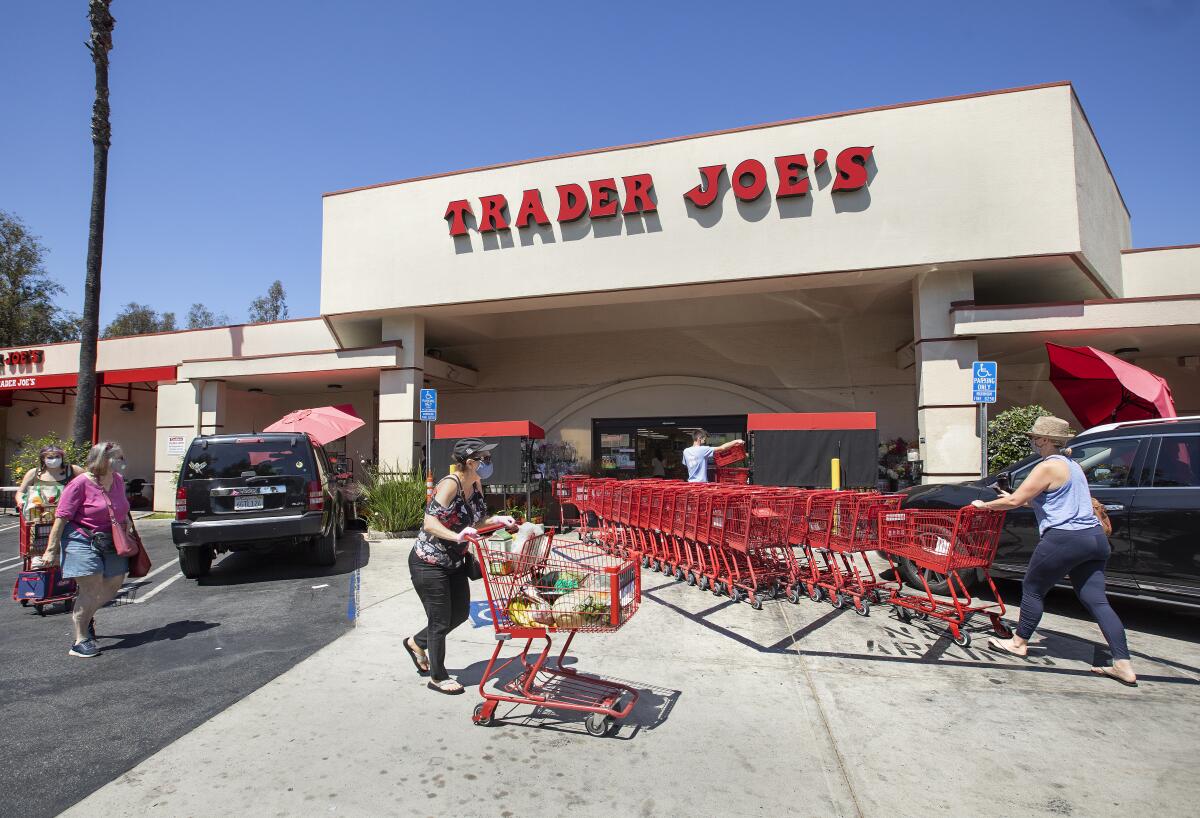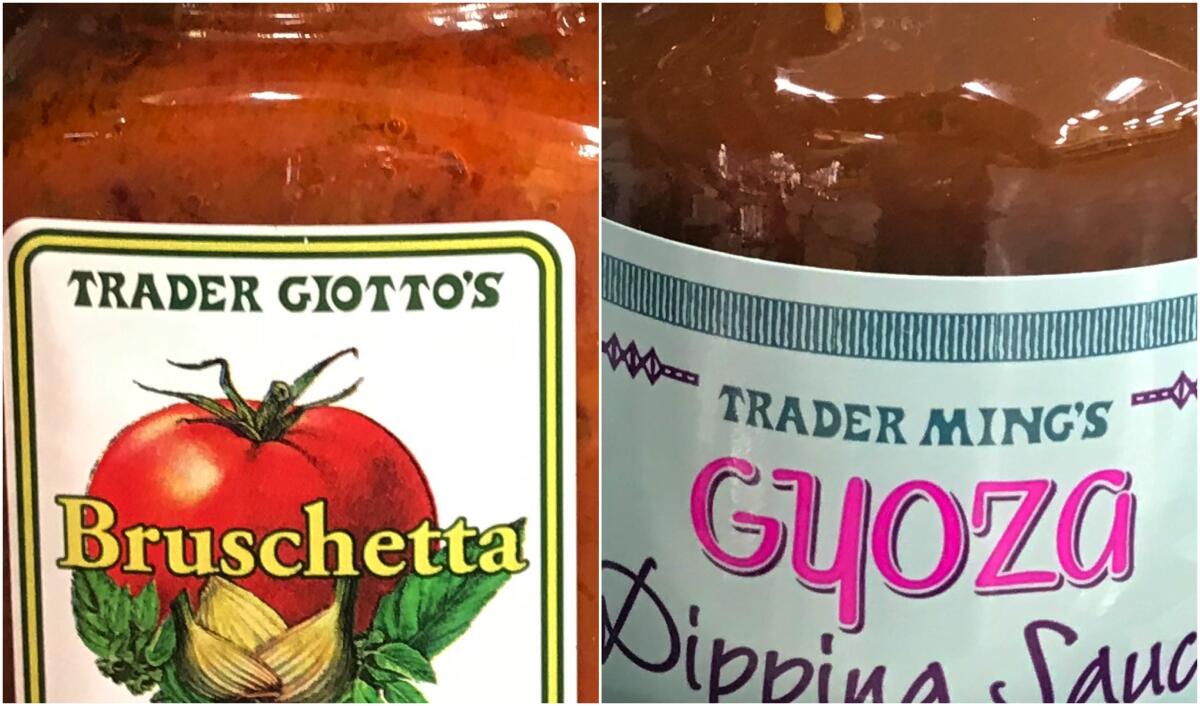If you’re in love with Trader Joe’s, its stances can also break your heart

- Share via
Grocery chain Trader Joe’s has built a devoted following that other brands might only dream of.
It has a podcast. It prints an old-timey newsletter called the Fearless Flyer that makes readers laugh out loud. Fans rave about the high-quality, affordable groceries and the friendly employees who wear Hawaiian shirts. Some people even go out of their way to live near a Trader Joe’s.
That’s the fruit of the Monrovia company’s efforts to create a fun and quirky shopping experience. But today’s increasingly polarized society puts Trader Joe’s in a tough spot: It can’t please everyone anymore.
Recent criticism has charged that branding it uses on certain product lines, such as Trader Ming’s and Trader José’s, are racist.
An online petition gathered thousands of signatures last month, and when Trader Joe’s said it had long since begun phasing out those labels, headlines trumpeted that the chain was changing its ways. Backlash followed, and then the company changed the tone of its messaging, distancing itself from the petition.
Having to contend with a wedge issue could be a turnoff for younger shoppers, who tend to want the companies they support to have social values that dovetail with their own.

“They’re looking for that community and that brand promise,” said Courtney Newell, chief executive of Crowned Marketing and Communications and author of “FutureProof: The Blueprint for Building a Brand Gen Z and Millennials Love.” “Those are really the things that are going to drive their [purchasing] decisions.”
If shoppers embrace a brand because it resonates with them emotionally, then a difference of opinion can feel like a betrayal.
Lupita Huerta used to decide where she’d live based in part on how close it was to a Trader Joe’s store. But the chain’s stances during this time of nationwide unrest did not sit well with her.
“The packaging is just the bottom of the barrel, the low-hanging fruit” that’s easy to change, said Huerta, a 30-year-old transportation planner from El Monte. “This is really a time where companies need to reflect on what their goal is in this movement and how they can push forward racial justice in their day-to-day operations.”
After seeing the company’s response and reading reports of its opposition to employee unionization efforts, Huerta stopped shopping at Trader Joe’s. She now goes to Sprouts.
The controversy flared last month after a Change.org petition called on Trader Joe’s to change the packaging on some food items — instead of being branded under the usual Trader Joe’s name, some Mexican-style food products are labeled “Trader José’s,” and some Chinese-style foods, “Trader Ming’s.”
The grocery chain has also used “Trader Joe San” for Japanese-style food, “Trader Giotto’s” for Italian-style food and “Trader Jacques’” for French-style items, and it says it has fully phased out “Arabian Joe’s” and “Armenian Joe’s,” which used to appear on Middle Eastern- and Armenian-style products, respectively. Some of these are other languages’ versions of the name Joe, while others clearly are not.
The petition, which garnered more than 5,000 signatures, said the variation on packaging “perpetuates harmful stereotypes” and “exoticizes other cultures.”
The nation is facing a reckoning over race that has prompted reconsideration of brands that have peddled racial stereotypes, such as Aunt Jemima and Uncle Ben’s. Ice cream bar Eskimo Pie will also be rebranded after its owner said in June that it recognized the term was “derogatory.”
After news of the petition broke, Trader Joe’s released a statement saying it had actually decided several years ago to start phasing out the product labels.
“While this approach to product naming may have been rooted in a lighthearted attempt at inclusiveness, we recognize that it may now have the opposite effect,” spokeswoman Kenya Friend-Daniel said at the time.
But days later, Trader Joe’s issued a second statement, this time saying, “We disagree that any of these labels are racist.” The company added that the petition did not influence its actions and that it had discontinued some names and products because not enough people bought them. “Products that resonate with our customers and sell well will remain on our shelves,” it said at the time.
The second public statement seemed to undermine the first — an unusual move, said Tim Calkins, clinical professor of marketing at Northwestern University’s Kellogg School of Management.
“Most brands, when it comes to issues of racism, they work very hard to avoid controversy,” he said. “Trader Joe’s is doing the opposite. Trader Joe’s is inviting people to opine on whether these labels are appropriate in the world today.”
The second statement may have been the company’s attempt to set the record straight, particularly if it felt it was being criticized or misunderstood, said Fred Cook, director of the USC Center for Public Relations at the Annenberg School and chairman of public relations firm Golin.
“I think of Trader Joe’s specifically as a very socially conscious company by nature,” he said. “However, there is a heightened sensitivity right now around all of these issues. Every company ... needs to be very careful about the kinds of things they’re saying and the kinds of things they’re doing.”
But the controversy isn’t expected to cause the chain lasting damage.
“There are still people out there that love Trader Joe’s,” Calkins said. “That will be the case as they work through this, during this and when they come out of this as well.”
When The Times invited readers this week to share their feelings about the chain, responses poured in. Trader Joe’s shoppers name-dropped dozens of items they loved, including fleur de sel caramels, Just the Clusters cereal, gluten-free toaster waffles and the summer special key lime pie. They talked about the table of food samples in each store. And they noted the ringing bells that serve as a sort of musical messaging system for staff.
The store’s smaller size, more limited selection of items (usually about 2,000 to 3,000, compared to the average Walmart’s 150,000 items) and affordable pricing make shopping at Trader Joe’s a different experience than at most grocery stores, said Burt P. Flickinger III, managing director of Strategic Resource Group, a retail and consumer goods consulting firm.
“They stay in a rhythm of retail that provides the best bargains and the best quality, but while they stay in the rhythm of retail, they do it in a offbeat and zany way,” he said.
More than 80 of the 100-plus readers who responded to The Times’ call for opinions said the labels would not change their feelings about Trader Joe’s or its products. Several said that the controversy was overblown, that the labels were simply part of the chain’s whimsical brand or that the packaging paid proper tribute to cultures.
As a German immigrant, Roswitha Koeper, 32, said she liked seeing bread products and pretzels imported from Germany on Trader Joe’s shelves, some of which were branded “Baker Josef’s” — though she emphasized that her experience as a white German immigrant was very different from the experiences of people of color.
“It always kind of makes me happy to see that [Baker Josef’s label] because for me … that means that they just went out of their way to see where this product comes from,” she said.
Non-German baking products have also carried the Baker Josef’s name over the years, including all-purpose flour and gluten-free cornbread mix.
Elke Kolodinski has shopped at Trader Joe’s since her college days in the 1990s, and even then, she thought labels such as “Trader José’s” were a bit juvenile and silly.
The Rancho Palos Verdes resident said she doesn’t care too much about the branding, though what’s most important to her is that the grocery store keeps stocking high-quality items at decent prices that stay on the cusp of what’s new in the food world.
More to Read
Inside the business of entertainment
The Wide Shot brings you news, analysis and insights on everything from streaming wars to production — and what it all means for the future.
You may occasionally receive promotional content from the Los Angeles Times.











